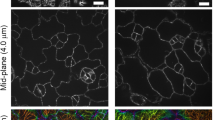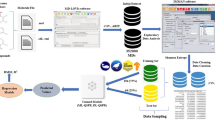Abstract
The inhibitory activity towards p34cdc 2/cyclin b kinase (CBK) enzyme of 30 cytokinin-derived compounds has been successfully modelled using 2D spatial autocorrelation vectors. Predictive linear and non-linear models were obtained by forward stepwise multi-linear regression analysis (MRA) and artificial neural network (ANN) approaches respectively. A variable selection routine that selected relevant non-linear information from the data set was employed prior to networks training.
The best ANN with three input variables was able to explain about 87% data variance in comparison with 80% by the linear equation using the same number of descriptors. Similarly, the neural network had higher predictive power. The MRA model showed a linear dependence between the inhibitory activities and the spatial distributions of masses, electronegativities and van der Waals volumes on the inhibitors molecules. Meanwhile, ANN model evidenced the occurrence of non-linear relationships between the inhibitory activity and the mass distribution at different topological distance on the cytokinin-derived compounds. Furthermore, inhibitors were well distributed regarding its activity levels in a Kohonen self-organizing map (SOM) built using the input variables of the best neural network.
Similar content being viewed by others
References
Aoyama, T., Suzuki, Y., Ichikawa, H., 1990. Neural networks applied to structure–activity relationships. J. Med. Chem. 33, 905–908.
Arris, C.E., Boyle, F.T., Calvert, A.H., Curtin, N.J., Endicott, J.A., Garman, E.F., Gibson, A.E., Golding, B.T., Grant, S., Griffin, R.J., Jewsbury, P., Johnson, L.N., Lawrie, A.M., Newell, D.R., Noble, M.E.M., Sausville, E.A., Schultz, R., Yu, W., 2000. Identification of novel purine and pyrimidine cyclin-dependent kinase inhibitors with distinct molecular interactions and tumor cell growth inhibition profiles. J. Med. Chem. 43, 2797–2804.
Bauknecht, H., Zell, A., Bayer, H., Levi, P., Wagener, M., Sadowski, J., Gasteriger, J., 1996, Locating biologically active compounds in medium-sized heterogeneous datasets by dopological autocorrelation vectors: Dopamine and benzodiazepine agonist. J. Chem. Inform. Comput. Sci. 36, 1205–1213.
D'Agostino, I.B., Kieber, J.J., 1999. Molecular mechanisms of cytokinin action. Curr. Opin. Plant Biol. 2, 359–364.
Demuth, H., Beale, M., 2003a. Neural Network Toolbox User's Guide for Use with MATLAB, 4th edn. The Mathworks Inc., Massachusetts, pp. 51–61, Chapter 5.
Demuth, H., Beale, M., 2003b. Neural Network Toolbox User's Guide for Use with MATLAB, 4th edn. The Mathworks Inc., Massachusetts, pp. 9–23, Chapter 8.
Devillers, J., 1999. Autocorrelation descriptors for modelling (eco)toxicological endpoints. In: Devillers, J., Balaban, A.T. (Eds.), Topological Indices and Related Descriptors in QSAR and QSPR. Gordon and Breach Science Publishers, pp. 595–612.
Devillers, J., Domine, D., 1997. Comparison of rehability of log P values calculated from a group contribution approach and from the autocorrelation method. SAR QSAR Environ. Res. 7, 195–232.
Dewar, M.J.S., Zoebisch, E.G., Healy, E.T., Stewart, J.J.P., 1985. AME: New general purpose quantum mechanical molecular model. J. Am. Chem. Soc. 107, 3902–3910.
Frank, J., 1993. Seiler Research Laboratory, MOPAC version 6.0. U.S. Air Force Academy.
Gasteiger, J., Zupan, J., 1995. Neural networks in chemistry. Angew. Chem. Int. Ed. Engl. 32, 503–527.
Gasteiger, J., Li, X., 1994. Abbildung elektrostatischer Potentiale muscarinischer und nicotinischer Agonisten mit künstlichen neuronalen Netzen. Angew. Chem. 106, 671–674.
Geary, R.F., 1954. The contiguity ratio and statistical mapping. Incorp. Stat. 5, 115–145.
González, M.P., Helguera, A.M., González-Díaz, H., 2004. A TOPS-MODE approach to predict permeability coefficients. Polymer 45, 2073–2079.
González, M.P., Terán, C., 2004a. A TOPS-MODE approach to predict adenosine kinase inhibition. Bioorg. Med. Chem. Lett. 14, 3077–3079.
González, M.P., Terán, C., 2004b. QSAR study of N6-(substituted-phenylearbamoyl) adenosine-5′-uronamides as agonist for A1 adenosine receptors. Bull. Math. Biol. 66, 907–920.
Guo-Zheng, L., Jie, Y., Hai-Feng, S., Shang-Sheng, Y., Wen-Cong, L., Nian-Yi, C., 2004. Semiempirical quantum chemical method and artificial neural networks applied for λmax. Computation of some azo dyes. J. Chem. Inform. Comput. Sci. 44, 2047–2050.
Haberer, G., Kieber, J.J., 2002. Cytokinins, new insights into a classic ophytohormone. Plant Physiol. 128, 354–362.
Havlíček, I., Hanuš, J., Veselý, J., Leclere, S., Meijer, I., Shaw, G., Strnad, M., 1997. Cytokinin-derived cyclin-dependent kinase inhibitors: Synthesis and cdc2 inhibitory activity of olomoucine and related compounds. J. Med. Chem. 40, 408–412.
Hawkins, D.M., 2004. The problem of overfitting. J. Chem. Inform. Comput. Sci. 44, 1–12.
Hemmateenejad, B., Akhond, M., Miri, R., Shamsipur, M., 2003. Genetic algorithm applied to the selection of factors in principal component-artificial neural networks: Application to QSAR study of calcium channel antagonist activity of 1,4-dihydropyridines (nifedipine analogous). J. Chem. Inform. Comput. Sci. 43, 1328–1334.
Kohonen, T., 1982. Self-organized formation of topologically correct feature maps. Biol. Cybernet. 43, 59–69.
Kolmogorov, A.N., 1957. Doklady Akademiia Nauk SSSR. 114, 953–954.
Kowalsky, R.B., Wold, S., 1982. Pattern recognition in chemistry. In: Krishnaiah, P.R., Kamal, L.N. (Eds.), Handbook of Statistics. North-Holland, Amsterdam, pp. 673–697.
Kubinyi, H., 1993. QSAR: Hansch Analysis and Related Approaches. VCH, New York.
Meijer, L., Raymond, E., 2003. Roscovitine and other purines as kinase inhibitors from starfish oocytes to clinical trials. Acc. Chem. Res. 36, 417–425.
Meijer, L., Leelere, S., Leost, M., 1999. Properties and potential applications of chemical inhibitors of cyclin-dependent kinases. Pharmacol. Ther. 82, 279–284.
Mok, M.C., Martin, R.C., Mok, D.W., 2000. Cytokinins: Biosynthesis, metabolism and perception. In Vitro Cell. Dev. Biol. Plant. 36, 102–107.
Moran, P.A.P., 1950. Notes on continuous stochastic processes. Biometrika 37, 17–23.
Moreau, G., Broto, P., 1980a. Autocorrelation of a topological structure: A new molecular descriptor. Nouv. J. Chim. 4, 359–360.
Moreau, G., Broto, P., 1980b. Autocorrelation of Molecular structures: Application to SAR studies. Nouv. J. Chim. 4, 757–764.
So, S., Richards, W.G., 1992. Application of neural network: Quantitative structure–activity relationships of the derivatives of 2,4-diamino-5-(substituted-benzyl)pyrimidines as DHFR inhibitors. J. Med. Chem. 35, 3201–3207.
StatSoft Inc, 2001. STATISTICA (data analysis software system), version 6. www.statsoft.com.
StatSoft Inc, 2004. Electronic Statistics Textbook. StatSoft, Tulsa, OK, web: http://www.statsoft.com/textbook/stathome.html.
Sumpter, B.G., Getino, C., Noid, D.W., 1994. Theory and applications of neural computing in chemical science. Annu. Rev. Phys. Chem. 45, 439–481.
The MathWorks Inc. (2002). MATLAB version 6.5. www.mathworks.com.
Todeschini, R., Consonni, V., 2000. Handbook of Molecular Descriptors. Wiley-VCH, Weinheim.
Todeschini, R., Consonni, V., Pavan, M., 2003. DRAGON, version 2.1.
Vanyúr, R., Héberger, K., Jakus, J., 2003. Prediction of anti-HIV-I activity of a series of tetrapyrrole molecules. J. Chem. Inform. Comput. Sci. 43, 1829–1836.
Wagener, M., Sadowski, J., Gasteiger, J., 1995. Autocorrelation of molecular properties for modelling corticosteroid binding globulin and cytosolic Ah receptor activity by neural networks. J. Am. Chem. Soc. 117, 7769–7775.
Werner, T., Motyka, V., Strnad, M., Schmülling, T., 2001. Regulation of plant growth by cytokinin. Proc. Natl. Acad. Sci. U.S.A. 98, 10487–10492.
Yasri, A., Hartsough, D., 2001. Toward an optimal procedure for variable selection and QSAR model building. J. Chem. Inform. Comput. Sci. 41, 1218–1227.
Zahouily, M., Rhihil Bazoui, A., Sebti, S., Zakarya, D., 2002. Structure–cytotoxicity relationships for a series of HEPT derivatives. J. Mol. Model. 8, 168–172.
Author information
Authors and Affiliations
Corresponding author
Rights and permissions
About this article
Cite this article
González, M.P., Caballero, J., Helguera, A.M. et al. 2D Autocorrelation Modelling of the Inhibitory Activity of Cytokinin-Derived Cyclin-Dependent Kinase Inhibitors. Bull. Math. Biol. 68, 735–751 (2006). https://doi.org/10.1007/s11538-005-9006-3
Received:
Accepted:
Published:
Issue Date:
DOI: https://doi.org/10.1007/s11538-005-9006-3




